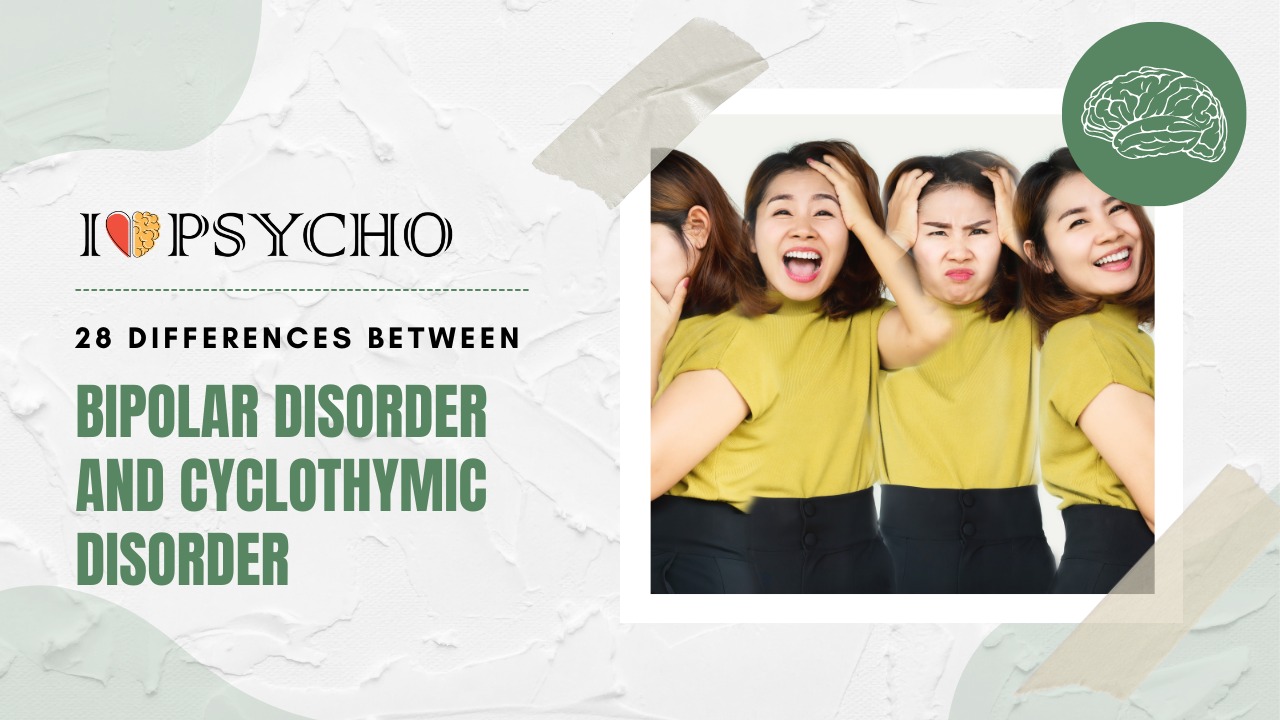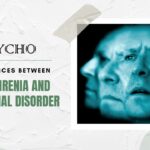Bipolar Disorder, also known as manic-depressive disorder, causes significant mood fluctuations from depressive bouts of deep melancholy and lethargy to manic moments of high mood, impulsivity, and vitality. These mood swings are more severe and impair daily life. Bipolar Disorder has two types: Bipolar I (intense manic and depressive episodes) and Bipolar II (less severe manic periods but more severe depression episodes). Psychotherapy and mood stabilizers help Bipolar Disorder patients manage their symptoms.
A milder mood illness is Cyclothymic illness. Chronic hypomania and moderate depression occur. Cyclothymic Disorder mood swings are milder and shorter than Bipolar Disorder’s. These mood fluctuations may not hinder everyday functioning like Bipolar Disorder, but they can affect quality of life over time. Cyclothymic Disorder is less disruptive but can lead to Bipolar Disorder.
The severity and duration of mood episodes distinguish the two. Bipolar Disorder causes strong manic and depression episodes that last weeks to months. Instead, Cyclothymic Disorder mood fluctuations are milder and persist for at least two years. The impact on an individual’s life varies greatly. The severity and unpredictability of mood episodes in Bipolar Disorder can affect relationships, careers, and well-being. However, Cyclothymic Disorder may create lesser mood swings that don’t usually impair living.
Overall, Bipolar Disorder and Cyclothymic Disorder both cause mood fluctuations, although they differ in intensity, duration, and life effect. Bipolar Disorder has more severe and long-lasting manic and depressed episodes and requires more rigorous treatment, while Cyclothymic Disorder has milder mood fluctuations and less impact on everyday life. Professional aid is needed for the correct diagnosis and treatment of mood disorders.
|
S. No. |
Aspects |
Bipolar Disorder |
Cyclothymic Disorder |
|
1 |
Definition |
A mood disorder characterized by episodes of mania and depression, which can be severe. |
A mood disorder characterized by cyclical mood swings, but they are less severe than in bipolar disorder. |
|
2 |
Mood Episodes |
Includes manic, depressive, and sometimes mixed episodes. |
Mood swings are milder, with hypomanic and depressive episodes. |
|
3 |
Severity of Mood Episodes |
Mood episodes are often severe and can lead to significant impairment. |
Mood episodes are less severe and do not typically cause severe impairment. |
|
4 |
Mania vs. Hypomania |
Manic episodes involve severe symptoms that can include psychosis. |
Hypomanic episodes are less severe, with symptoms not meeting the criteria for full-blown mania. |
|
5 |
Depression |
Depressive episodes can be severe and debilitating. |
Depressive episodes are less severe but can still cause impairment. |
|
6 |
Duration of Mood Episodes |
Mood episodes in bipolar disorder can last for weeks to months. |
Mood episodes in cyclothymic disorder are shorter in duration, typically lasting a few days to a few weeks. |
|
7 |
Frequency of Mood Episodes |
Mood episodes in bipolar disorder occur less frequently than in cyclothymic disorder. |
Cyclothymic disorder is characterized by frequent mood swings, often without long periods of stability. |
|
8 |
Stability |
Individuals with bipolar disorder may have long periods of mood stability between episodes. |
Individuals with cyclothymic disorder experience chronic mood instability. |
|
9 |
Diagnosis |
Diagnosed based on the presence of distinct manic and depressive episodes. |
Diagnosed when there is a history of numerous periods of hypomanic and depressive symptoms over at least 2 years. |
|
10 |
Psychosis |
Psychotic features may occur during manic or depressive episodes in bipolar disorder. |
Psychotic features are less common in cyclothymic disorder. |
|
11 |
Impairment |
Bipolar disorder can cause significant impairment in daily functioning during mood episodes. |
Cyclothymic disorder can cause impairment but to a lesser degree than bipolar disorder. |
|
12 |
Medication |
Typically treated with mood stabilizers, antipsychotics, and antidepressants (for bipolar depression). |
Treatment may involve mood stabilizers and psychotherapy. |
|
13 |
Age of Onset |
Often begins in late adolescence or early adulthood. |
May have an earlier onset, often in adolescence or early adulthood. |
|
14 |
Risk of Suicide |
Higher risk of suicide during depressive episodes in bipolar disorder. |
Lower risk of suicide compared to bipolar disorder but still a concern during depressive episodes. |
|
15 |
Genetics |
Strong genetic component, with a family history of mood disorders common. |
Genetic factors may play a role, but it is less well-defined than in bipolar disorder. |
|
16 |
Subtypes |
Includes bipolar I (manic episodes), bipolar II (hypomanic and depressive episodes), and cyclothymic disorder. |
Cyclothymic disorder is a subtype of bipolar disorder. |
|
17 |
Course |
Can have a chronic or episodic course, with varying degrees of symptom severity. |
Characterized by a chronic, stable course with frequent mood fluctuations. |
|
18 |
Euthymic Periods |
Individuals may experience extended periods of euthymia (mood stability) between episodes. |
Euthymic periods are shorter and less common in cyclothymic disorder. |
|
19 |
Lifetime Prevalence |
Less common than cyclothymic disorder. |
Less common than bipolar disorder. |
|
20 |
Functional Impairment |
During mood episodes, functional impairment is often significant. |
Functional impairment may be present but is generally less severe. |
|
21 |
Diagnosis Criteria |
Specific diagnostic criteria for mania, hypomania, and depression. |
Diagnosis based on a pattern of chronic mood swings without meeting criteria for a full mood episode. |
|
22 |
Treatment Emphasis |
Treatment is focused on stabilizing mood during episodes and preventing relapse. |
Treatment aims to manage mood swings and improve overall mood stability. |
|
23 |
Cognitive Impairment |
May experience cognitive impairment during manic and depressive episodes. |
Cognitive impairment during mood swings is generally less pronounced. |
|
24 |
Substance Abuse |
Increased risk of substance abuse, especially during manic episodes. |
Substance abuse risk may be lower, but some individuals may still misuse substances. |
|
25 |
Neurobiology |
Altered brain chemistry and neurobiology play a significant role in bipolar disorder. |
Neurobiological mechanisms in cyclothymic disorder are less well understood. |
|
26 |
Comorbid Disorders |
Commonly co-occurs with anxiety disorders, substance use disorders, and other psychiatric conditions. |
May have comorbid conditions, but less frequently than bipolar disorder. |
|
27 |
Family Impact |
Family members may experience significant stress and disruption due to mood episodes. |
Family impact is generally less severe, as mood swings are less intense. |
|
28 |
Duration of Illness |
A lifelong condition that requires ongoing management. |
May persist for many years but is generally less chronic than bipolar disorder. |
Frequently Asked Questions (FAQs)
Q.1 What is Bipolar Disorder?
Bipolar Disorder causes significant mood fluctuations between mania and sadness. Manic periods contain high mood, vitality, and impulsivity, whereas depressed episodes involve deep sadness and poor energy. Bipolar Disorder has two types: Bipolar I (severe manic episodes) and Bipolar II (hypomanic and severe depression episodes).
Q.2 What is Cyclothymic Disorder?
Chronic hypomania and depression characterize Cyclothymic Disorder. Cyclothymic Disorder causes milder, more lasting mood fluctuations than Bipolar Disorder. Less severe and shorter mood swings last at least two years in adults and one year in adolescents and children.
Q.3 How do these illnesses affect life?
The severity and duration of mood episodes in Bipolar Disorder can affect many facets of life. It typically disrupts relationships, employment, and personal life. Cyclothymic Disorder is less disabling, yet it can still disrupt everyday living by affecting relationships and work performance.
q.4 Treatment options for these disorders?
The intensity of symptoms determines Bipolar Disorder and Cyclothymic Disorder therapy. To treat manic and depressive periods, bipolar disorder requires mood stabilizers, antipsychotics, and psychotherapy. Psychotherapy, mood monitoring, and lifestyle changes may assist Cyclothymic Disorder patients in controlling their mood fluctuations.
Q.5 Can these illnesses be diagnosed correctly?
Proficient mental health experts must diagnose Bipolar Disorder and Cyclothymic Disorder. They examine mood swing length, severity, patterns, and everyday life impact. Accurate diagnosis is necessary for personalized treatment regimens.









